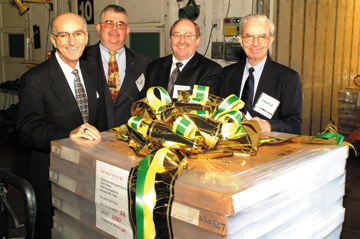
Geotimes Home | AGI Home | Information Services | Geoscience Education | Public Policy | Programs | Publications | Careers

As it tours through the atmosphere after its emission, carbon dioxide has a
long lifecycle — about 50 to 200 years. Soot, however, sticks around for
much less time — weeks to months. That’s why a reduction in soot emissions
has the potential to change global temperatures more quickly than a reduction
in carbon dioxide emissions, according to Mark Jacobson, associate professor
of civil and environmental engineering at Stanford University.
“In terms of its speed and relative magnitude of its effect on global climate,
controlling soot could possibly be the most effective method of controlling
global warming,” Jacobson says. In his study published in the October Journal
of Geophysical Research-Atmospheres, Jacobson uses numerical model simulations
to test various effects of aerosols on climate.
Soot, composed of black and organic carbon, absorbs a large amount of sunlight
and reradiates the absorbed heat into the atmosphere. The magnitude of its effect
on temperature is second to that of carbon dioxide and supersedes that of methane,
Jacobson says. Not only does soot have a stronger effect on climate per unit
mass than carbon dioxide, but it also carries with it deleterious health effects
that carbon dioxide does not — making soot a particularly attractive candidate
for emissions reduction, he says.
Diesel vehicles are perhaps the most well-known sources of the soot in the atmosphere.
In recent years, tax laws in all European Union countries, except the United
Kingdom, have favored diesel over gasoline in cars because gasoline vehicles
emit more carbon dioxide than diesel vehicles. As a major culprit in greenhouse
gas increases, carbon dioxide has appeared to pose the largest controllable
threat.
However, diesel cars without filters can emit 25 to 400 times more mass of soot
per kilometer than similar gasoline cars. That, Jacobson says, is cause for
rethinking the way we look at environmental regulations.
Particulate traps, now becoming more common on diesel vehicles, are an effective
way to reduce soot, Jacobson says, but even vehicles using such traps emit more
soot than gasoline cars. Vehicles with traps also use 3.5 percent more fuel.
Jacobson adds that the leading sources of soot in the atmosphere today in developed
countries are off-road vehicles and agricultural and construction equipment,
not diesel cars and trucks.
Jim Hansen, a climatologist at the NASA Goddard Institute for Space Sciences,
agrees that a reduction in soot will benefit both human health and climate.
“However, we must be careful not to oversell this climate effect,”
he says. “In practice, if we pay attention to reducing black carbon emissions,
probably the most cooling effect that we can get would be enough to balance
the warming that we will get by reducing sulfate aerosols,” referring to
worldwide efforts to reduce acid rain and air pollution that result from sulfur
emissions. Sulfate, a white aerosol, cools the atmosphere by reflecting sunlight.
Hansen stresses that a reduction in carbon dioxide and methane still must play
the major role in solving the global warming problem. Indeed, Jacobson says
that the bottom line of his research, funded by NASA, the Environmental Protection
Agency, the National Science Foundation, the David and Lucile Packard Foundation,
and the Hewlett-Packard Company, is that all emissions need to be taken seriously.
“You can reduce soot by any amount and you’ll get some benefit that
will be a faster benefit than controlling carbon dioxide. But it is necessary
to control soot and carbon dioxide, as well as methane.”
Lisa M. Pinsker
Back to top
 Oklahoma
geoscientists are beaming over the start of the arrival of more than 100,000 boxes
of earth core samples from oil and gas wells across the nation. BP donated the
cores, valued at $2.5 million, to the University of Oklahoma (OU) and the Oklahoma
Geological Survey along with a $3-million grant to support earth science research
programs. The core collection adds up to about 57 miles of cores weighing six
million pounds, as well as core analysis equipment and storage system components.
Oklahoma
geoscientists are beaming over the start of the arrival of more than 100,000 boxes
of earth core samples from oil and gas wells across the nation. BP donated the
cores, valued at $2.5 million, to the University of Oklahoma (OU) and the Oklahoma
Geological Survey along with a $3-million grant to support earth science research
programs. The core collection adds up to about 57 miles of cores weighing six
million pounds, as well as core analysis equipment and storage system components.
 |
Geotimes Home | AGI Home | Information Services | Geoscience Education | Public Policy | Programs | Publications | Careers |